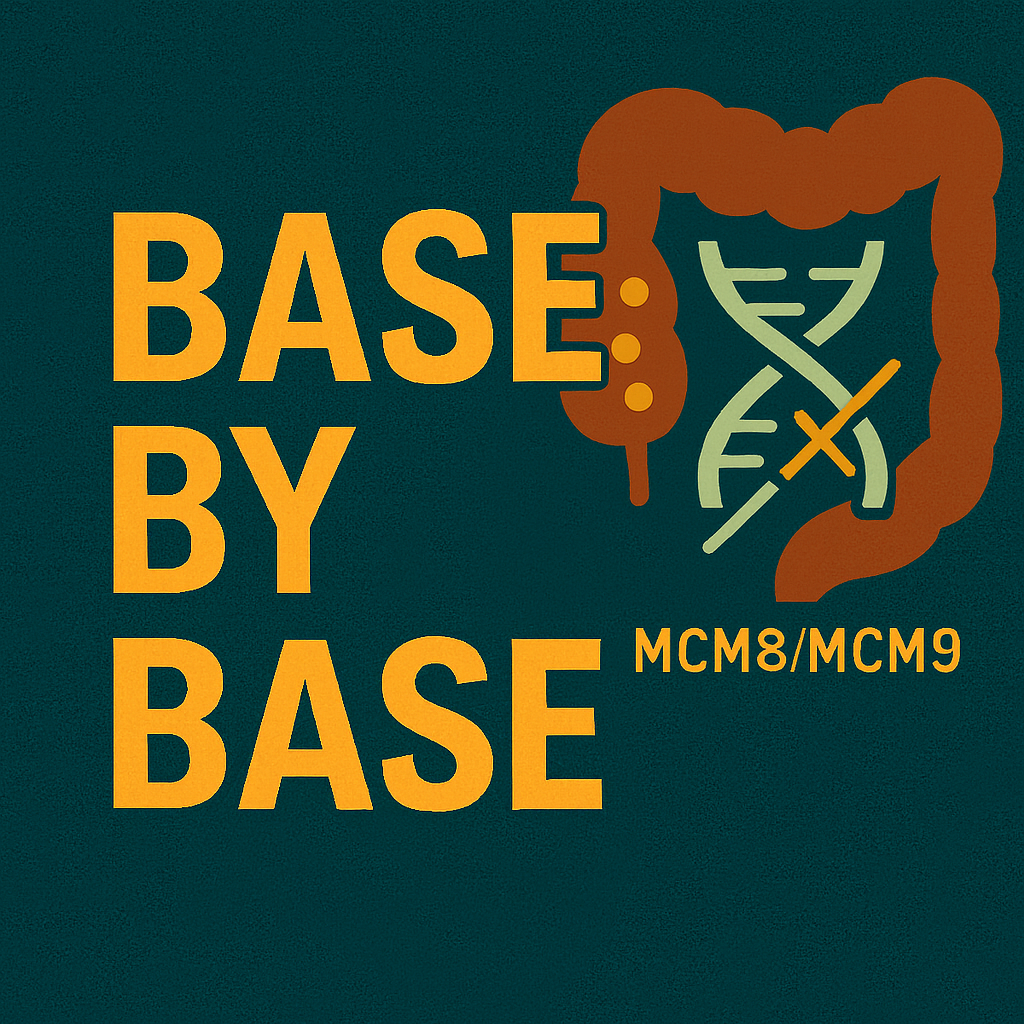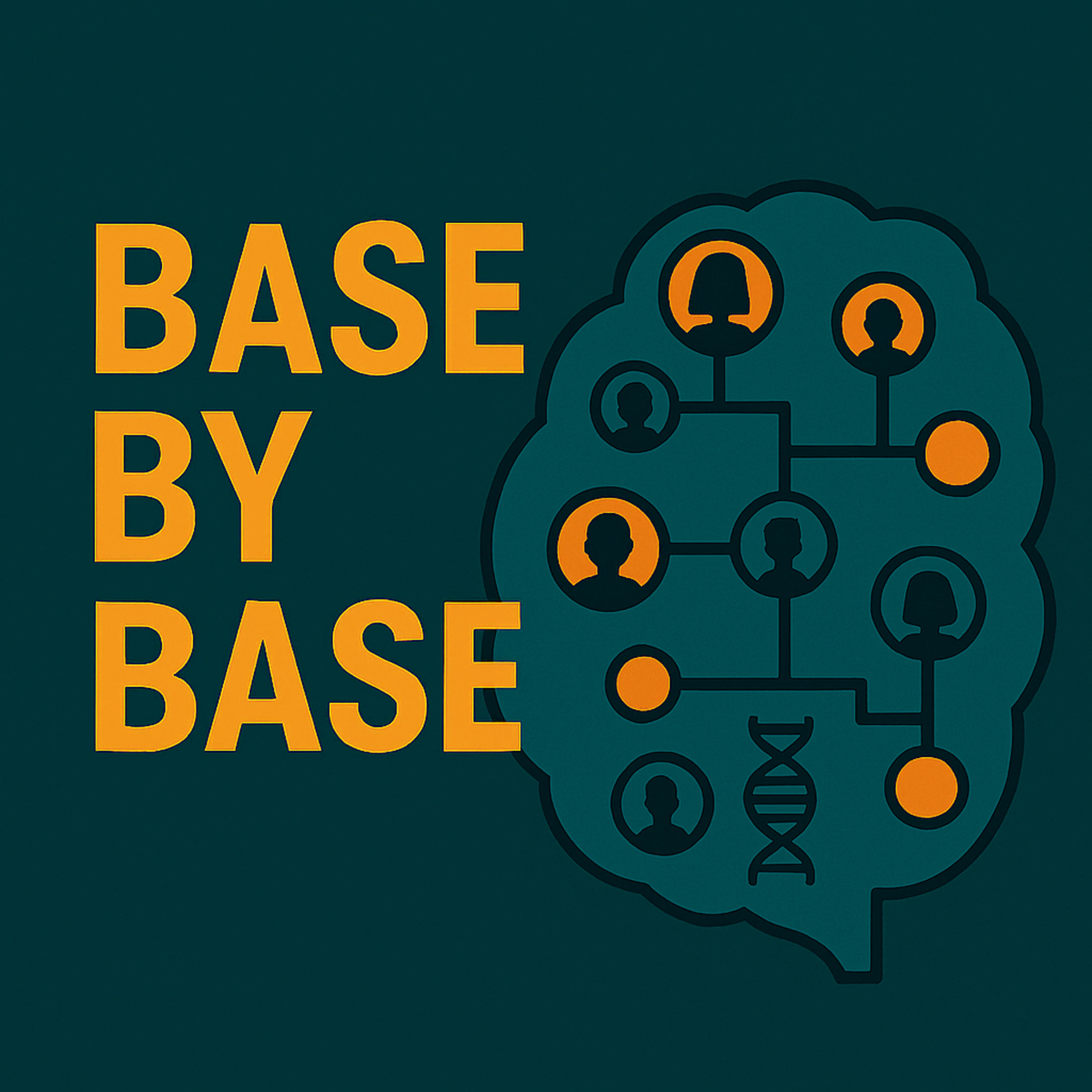Episode Transcript
[00:00:00] Speaker A: Foreign.
[00:00:14] Speaker B: Welcome to Base by Base, the papercast that brings genomics to you wherever you are. Today we're getting into, well, one of the really big challenges in clinical genetics, inherited cancer risk. I mean, we know that maybe up to 30% of families with a strong history of cancer walk into clinics and. And there's just no known genetic explanation.
[00:00:33] Speaker C: Yeah, it leaves them kind of hanging.
[00:00:34] Speaker B: Right.
[00:00:35] Speaker C: Facing all this uncertainty about what to do, how to screen, how to prevent it. But the sources we're looking at today, they focus on the study that found this really surprising connection. I mean, what if the exact same gene problem causes two things that seem totally unrelated, like early reproductive failure? Think primary ovarian insufficiency, poi. And also puts you at this huge risk for aggressive early cancers, especially in the gut. It sounds almost unbelievable linking some, something like infertility to a, well, a life saving cancer warning sign.
[00:01:01] Speaker A: That's precisely it. We're really unpacking the MCM8 and MCM9 genes here. For a long time, honestly, they were mostly just discussed when talking about fertility problems. But this paper, it really shifts the perspective. It says, hold on. Their role goes way beyond just fertility. It firmly points to them as newly defined factors for cancer predisposition.
[00:01:22] Speaker B: And that's not just interesting science. Right. That's critical for the clinic.
[00:01:25] Speaker A: Absolutely critical. Because, you know, unless you can actually put numbers on that risk, defined how high it is, you can't reliably add these genes to the standard screening panels doctors use every day.
[00:01:35] Speaker B: Right. So think about what this means for, you know, for a person out there. Imagine getting diagnosed with POI as a teenager, maybe early 20s, looking at early menopause, and then you find out the genetic reason behind it, also gives you this, well, frankly, terrifying risk for really serious cancers that start young, like gastric cancer or lots of colon polyps.
[00:01:56] Speaker A: Finding these specific genetic changes, we're talking about biallelic changes, meaning both copies of the gene are affected.
Finding those means we can finally move past that, that sort of vague risk. We can actually create a clear plan for surveillance, for prevention, starting potentially really early. So defining that whole picture, the full clinical spectrum, the actual cancer risk numbers, that's what this big international team aimed to do. That was the essential first step.
[00:02:23] Speaker B: And yeah, mapping out something this complex, you know, straddling reproduction in cancer, that definitely sounds like it needs a huge team effort.
So today we really should recognize the work of this truly international group. We're talking teams from Leiden University Medical Center, Princess Maximus center for Pediatric Oncology, UC San Diego and, well, many others too.
[00:02:44] Speaker A: Yeah, it's an incredible collaboration. They've really pushed forward our understanding of what happens when MCM8 or MCM9 aren't working properly, moving these genes from, you know, primarily fertility genes to clearly being involved in cancer risk.
[00:02:57] Speaker B: Okay, so to get why these genes can cause such different serious problems in fertility and cancer, we need to understand what they actually do.
What are these MCM8 and MCM9 proteins up to inside our cells?
[00:03:11] Speaker A: Well, they team up, they form something called a helicase complex. And helicases, you can think of them like molecular zippers. They're crucial for unwinding and rewinding the DNA strands.
[00:03:21] Speaker B: Ah, okay. So they're kind of fundamental mechanics for handling DNA, making sure everything runs smoothly.
[00:03:25] Speaker A: That's a great way to think about it. Yeah, because they act like zippers. This MCM89 complex is absolutely essential for really key DNA jobs like DNA replication, when cells copy their DNA. And also meiosis that's vital for making eggs and sperm, plus things like homologous recombination or HR and mismatch repair, mmr. These are major DNA repair pathways.
[00:03:46] Speaker B: Right. The cell's main fix, it crews.
[00:03:48] Speaker A: Exactly. So if you have a defect in a core piece of machinery like this, well, the logical outcome is genome instability. The DNA gets damaged more easily and repairs don't happen correctly.
[00:03:59] Speaker B: And historically, the link to fertility made sense because, you know, messing up meiosis would clearly lead to problems like poi. Right?
[00:04:07] Speaker A: Precisely. That was the established connection. But then maybe as genetic sequencing got more common, these little hints started popping up, you know, you know, individual case reports mentioning someone with maybe MCM8 or MCM9 variants who also had lots of polyps or colorectal cancer. Really young.
[00:04:24] Speaker B: Or just hints, like anecdotes.
[00:04:26] Speaker A: Exactly. Just anecdotal. And that was the big problem the study tackled head on, because you only had a few cases scattered here and there, you didn't know the full range of symptoms, and critically, you couldn't get accurate estimates of the cancer risk.
[00:04:40] Speaker B: And without those numbers, without the numbers.
[00:04:42] Speaker A: You can't really justify putting people through potentially invasive screening, like lots of colonoscopies, or recommend including these genes on the standard diagnostic test doctor's order. They just weren't quite there yet.
[00:04:53] Speaker B: Okay, so to get those definitive numbers, the kind needed to actually change clinical guidelines, they had to go bigger than just collecting a few more case reports. How did they do it? How'd they get the statistical muscle?
[00:05:05] Speaker A: They used this really robust, multi pronged strategy. Basically, they Built the biggest, most detailed group of these patients possible.
First step was compiling a core clinical case series. They gathered detailed information on 54 people known to have biallelic variants. So faults in both copies split pretty evenly. 26 for MCM 8 and 28 for MCM 9.
[00:05:27] Speaker B: Okay, so that gives you the deep clinical details on known carriers. But for population risk, you need, like, massive numbers, right?
[00:05:34] Speaker A: Exactly. So they brilliantly combined that detailed case series data with information from huge population databases, specifically the 100,000 Genomes Project here in the UK and also the massive 200,000 exome release from the UK Biobank.
[00:05:49] Speaker B: Wow.
[00:05:49] Speaker A: Yeah. Putting together that focused clinical group with the sheer scale of the biobanks, that's what finally gives you the statistical power to pin down the risks associated with these relatively rare conditions.
[00:05:59] Speaker B: That scale is definitely impressive. But, you know, with biobanks, you always worry about noise, Right? Just random genetic variations. How do they make sure they were focusing on variants that actually cause problems?
[00:06:08] Speaker A: They were really careful about that. Very strict filtering.
They only looked at variants that met tough criteria for pathogenicity. Things like the official ACM JMP guidelines, which are standard in clinical genetics. And also high CAD scores. CAD scores are basically computer predictions of how damaging a specific genetic change is likely to be.
[00:06:30] Speaker B: So filtering out the likely harmless stuff.
[00:06:32] Speaker A: Right? Making sure they focused on the variants most likely to be the culprits.
[00:06:36] Speaker B: And then the statistics comparing the carriers to everyone else. Using odds ratios.
[00:06:41] Speaker A: Correct. They calculated odds ratios, carefully adjusting for things like age, sex and ethnicity to see if having these biallelic variants made certain diseases significantly more common compared to the general population controls in the biobanks. But what really elevates this study, I think, is the molecular work they did next. They didn't just stop at the statistics. They got hold of tumor DNA from some of the carriers.
[00:07:03] Speaker B: Ah, to look inside the cancers themselves.
[00:07:06] Speaker A: Exactly. They looked for the specific driver mutations that were making those cancers grow. And crucially, they analyzed the mutational signatures. Think of these like, molecular fingerprints left behind in the DNA by the processes causing the mutations. They wanted to see if the MCM8 or MCM9 deficiency left a specific recognizable pattern of DNA damage.
[00:07:27] Speaker B: Like a signature that screams this repair pathway is broken.
[00:07:30] Speaker A: That was the hope. Yeah. To see if it matched known signatures for problems like HR deficiency or MMR deficiency.
[00:07:37] Speaker B: Okay, let's get into those findings, because this is where things get really clear, especially the differences between the two genes. And frankly, quite alarming. Starting with MCM9.
[00:07:46] Speaker A: Yeah. The data from the hundred thousand genomes Project was stark. It showed significant enrichment, meaning a much higher rate only for Biallelic MCM9 variants and only in specific digestive system diseases. The numbers really tell the story.
[00:07:59] Speaker B: Okay, give us the highlights. Or lowlights, maybe.
[00:08:01] Speaker A: Right. For colonic polyps, the odds ratio was 6.5:1, so over six times more likely. For rectal polyps, it was 8.4, so over eight times the risk. But the one that really jumps out, the one demanding immediate attention, was gastric cancer. The odds ratio there was a massive 27.03.27.
[00:08:20] Speaker B: Wow, that's. That's huge. That's not just a small increased risk. That's a major predisposition.
[00:08:25] Speaker A: It's an enormous predisposition compared to the general population. Yes, it absolutely flags MCM9 biallelic carriers as being at very high risk.
[00:08:32] Speaker B: Okay, an OR of 27 definitely signals a need for action. But what about the original connection, the reproductive problems? Did they still see that consistently in their clinical case series?
[00:08:42] Speaker A: Oh, absolutely. That original link was very much confirmed. Hypogonadism, the impaired development of reproductive organs, was seen in nearly everyone.
About 88% of the MCM8 carriers and 93% of the MCM9 carriers in their detailed series had signs of it. Often this meant things like a small or even absent uteri and ovaries. But now here's the really critical cancer risk that connects both genes. Both Biallelic MCM8 and Bialolic MCM9 variants showed a strong link to early onset germ cell tumors. Gcts. These are specific types of ovarian cancers.
[00:09:17] Speaker B: Okay, so GCTS for both. And you said early onset. How early?
[00:09:20] Speaker A: Incredibly early. Typically, these gcts were diagnosed in female carriers between the ages of just 11 and 15 years old.
[00:09:26] Speaker B: 11 to 15. That completely changes the con. We're talking about childhood cancer surveillance, then, not just adult risk.
[00:09:32] Speaker A: Precisely. It shifts the timeline dramatically.
[00:09:34] Speaker B: Okay, now back to that molecular analysis you mentioned. This is where you said it got a bit puzzling, given that McMahon and MCM9 are involved in these heavy duty repair pathways, HR and MMR. What did the tumor DNA actually show? Did it have that expected repair pathway broken signature?
[00:09:48] Speaker A: Well, this is the unexpected part, the sort of molecular mystery you'd expect, given their role, that tumors arising because these genes are faulty would show massive genomic chaos. Right. Maybe signatures characteristic of severe HR deficiency, like you see with BRCA mutations or MMR deficiency, like in lynch syndrome.
[00:10:07] Speaker B: Yeah, makes sense.
[00:10:08] Speaker A: But that's not predominantly what they found. Instead, the tumors they analyzed mostly showed what are called Clock like mutational signatures. Specifically signatures known as SBS1 and SBS5.
[00:10:20] Speaker B: Wait, clock like, aren't those the signatures that just sort of accumulate over time with normal cell division and aging? They're found in loads of regular sporadic canc that aren't tied to major repair defects.
[00:10:31] Speaker A: Exactly. SBS1 and SPS5 are ubiquitous. They're thought to reflect baseline mutation processes happening in most cells as they divide and age.
[00:10:40] Speaker B: So if these genes are so vital for DNA repair and losing them causes this massive cancer risk, why aren't the tumors riddled with the expected damage signatures? Why these common, almost background noise signatures instead? That feels counterintuitive.
[00:10:54] Speaker A: It is counterintuitive. And honestly, it's puzzling. It suggests that while the MCM8 MCM9 defect definitely causes genomic instability leading to cancer, the way it does so might be more complex or different than the straightforward breakdown of HR or MMR pathways we see in other syndromes. Maybe the instability it causes is of a different kind. Or maybe it enables other mutation processes to take over. It means the underlying mechanism of how these defects drive cancer isn't as simple as we might have assumed. Assumed. That's definitely an area for more research.
[00:11:27] Speaker B: Okay, so the exact how at the molecular level is still a bit fuzzy. But the clinical data, the population data, confirming the risk itself, especially for MCM9 and GI cancers and for GCTS for both, that seems undeniable now.
[00:11:41] Speaker A: Undeniable. And that certainty is what allows for changes in clinical practice. This study really provides the solid evidence needed to say, yes, MCM 8 and MCM 9 should be included on diagnostic gene panels.
[00:11:53] Speaker B: Especially when.
[00:11:53] Speaker A: Especially when doctors see patients with unexplained polyposis or early onset gastric cancer, or those early germ cell tumors or even early onset colorectal cancer. And particularly if there's also a history of reproductive problems like poi, or if the family history suggests a recessive inheritance pattern, meaning it only shows up when someone inherits faulty copies from both parents.
[00:12:15] Speaker B: And that translates directly into actual advice for patients, right? Potential new surveillance guidelines to save lives. So, based on that huge. OR for gastric cancer with MCM9 and the polyps risk, what should surveillance look like?
[00:12:29] Speaker A: Well, for people with bialelic MCM9 variants, given that high risk for polyps and colorectal cancer, the thinking now moves towards starting colon surveillance much earlier. Similar protocols to those used for other polyposis syndromes like Mutyh or Nthl1 associated polyposis, which likely means starting regular colonoscopies around age 25. And this is crucial because of that extremely high gastric cancer risk. Doing concurrent gastroscopy, looking into the stomach at the same time should also be strongly considered maybe starting around the same age.
[00:13:00] Speaker B: Okay. Colon and stomach scopes starting young for MCM9.
What about the germ cell tumor risk for both MCM8 and MCM9 carriers?
That incredibly early onset between 11 and 15?
[00:13:13] Speaker A: Yeah, that finding really points towards a need for proactive screening in childhood for female carriers with biallelic MCM8 or MCM9 variants. The data strongly suggests considering annual ultrasound screening of the ovaries.
[00:13:27] Speaker B: Starting when?
[00:13:28] Speaker A: Starting potentially as early as age 10. The idea is to catch any developing GCT at the earliest possible stage when they are highly treatable. That's a really powerful concrete recommendation coming.
[00:13:39] Speaker B: Out of this work that is profound, catching potential ovarian cancer that early.
But we should probably add a note of caution about people who only carry one faulty copy of the gene, the monoallic carriers. Does the data suggest they face these same high cancer risks?
[00:13:52] Speaker A: That's a really important distinction to make. While some monoallic carriers were noted in the study's case series, the current evidence, especially from the large population datasets, suggests their main clinical issue, if any, seems to be primarily related to hypogonadism. That was seen in maybe 22% to.
[00:14:07] Speaker B: 29% of those cases, but not the high cancer rates.
[00:14:11] Speaker A: As of now, there isn't clear evidence to justify putting monoallic carriers through the same intensive cancer surveillance protocols recommended for the biallelic carriers.
So for cancer prevention, the clinical focus really remains on those with two faulty gene copies.
[00:14:26] Speaker B: Okay, that's clear.
And finally, like with any big study, especially one using large biobanks, we should touch on limitations.
Did the researchers point out any caveats?
[00:14:36] Speaker A: They did, and it's good scientific practice to acknowledge them. They mention two main things. First, potential ascertainment bias. Because many of the initial patients in their case series were recruited from fertility clinics, the frequency of hypogonadism in their specific group might look a bit higher than in the general population of carriers.
[00:14:55] Speaker B: Makes sense. And the second?
[00:14:56] Speaker A: The second is about relying on the diagnostic codes used in the biobanks. You know, the ICD codes doctors assign. These might not always be of part perfectly accurate or capture the full picture for every single person in a database of hundreds of thousands.
So it's possible the true prevalence of some cancers might be slightly under or overestimated by relying solely on those codes.
[00:15:17] Speaker B: Right. Inherent challenges with huge datasets. But those limitations don't really take away from the core finding, do they? This still feels like a major step forward.
[00:15:26] Speaker A: Oh absolutely.
Despite those caveats, this study stands as the most thorough, most important characterization of people with biallelic MCM8 and MCM9 defects. We have to date the key take home message is that these genes are now firmly established as genetic factors that link two major health issues, early reproductive failure and a significant quantifiable risk for hereditary cancer.
[00:15:47] Speaker B: And that distinction between the genes is crucial for action. Biallelic MCM9 means that alarming risk for polyps and upper GI cancers, especially stomach cancer, whereas both Bialic McMahon and MCM9 carry that risk for early onset germ cell tumors. Needing that childhood screening approach.
[00:16:04] Speaker A: Exactly. Which leads us to the big question moving forward, really, what does this data mean for how we design genetic testing panels around the world? How do we make sure that individuals, particularly women, who come in seeking help for fertility issues or are diagnosed with POI are also appropriately assessed and screened for these potentially life saving cancer risks? That's the challenge for clinical genetics globally now.
[00:16:29] Speaker B: This episode was based on an Open Access article under the CC BY 4.0 license. You can find a direct link to the paper and the license in our episode description. If you enjoyed this, follow or subscribe in your podcast app and leave a five star rating. If you'd like to support our work, use the donation link in the description. Thanks for listening and join us next time as we explore more science base by base.
[00:16:56] Speaker A: Sam.




